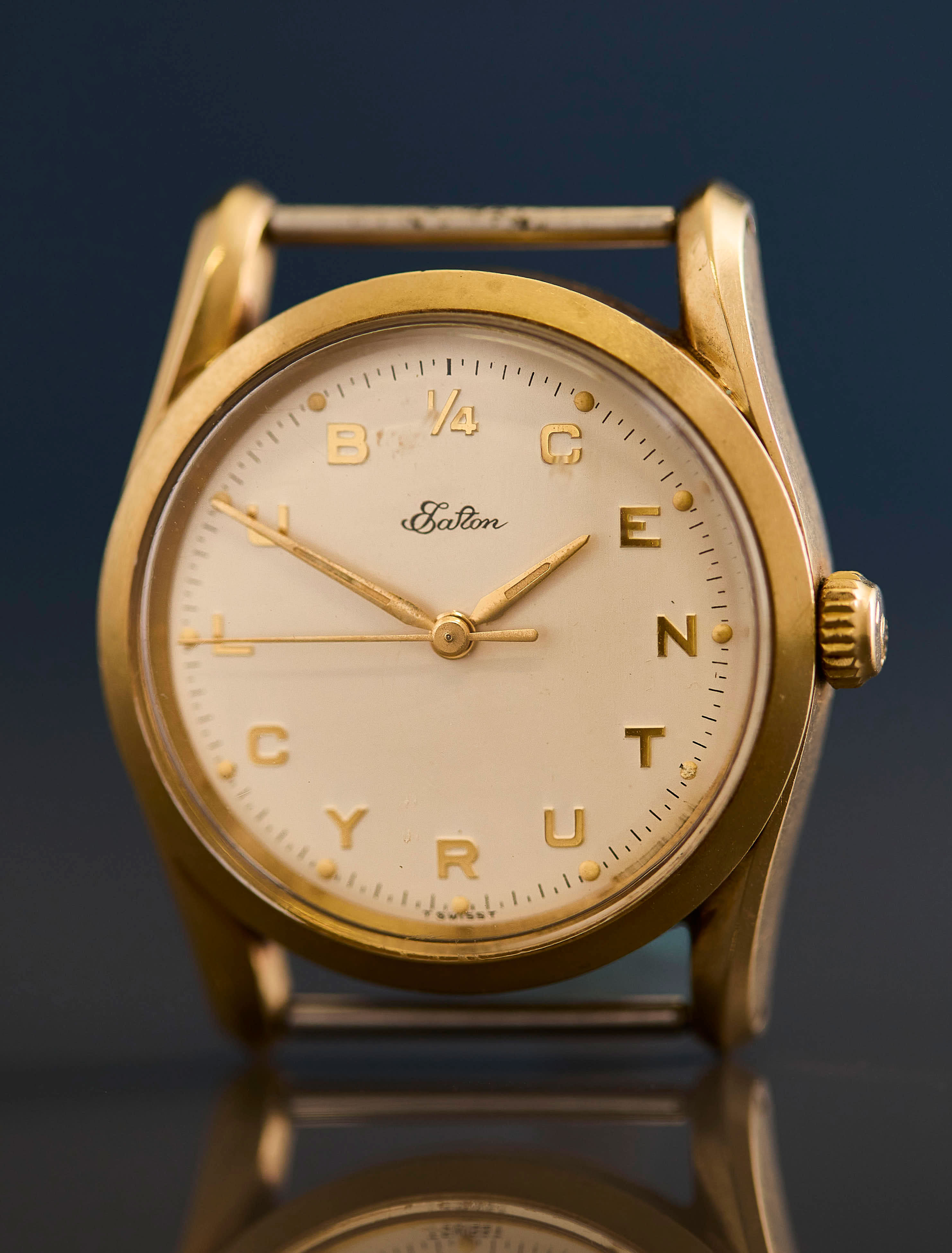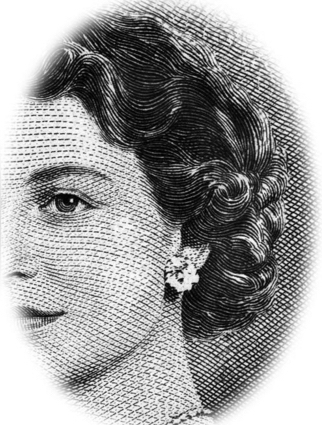If you wanted to tell a country’s history through objects, money wouldn’t be a bad place to start. Waddington’s is pleased to be presenting several interesting notes in our Numismatics auction, August 26-31, which prompted us to highlight five notable notes each of which capture a moment in our nation’s history.
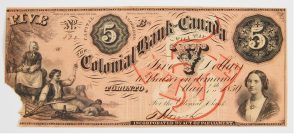
1859 Colonial Bank of Canada $5 Note
Though this 1859 Colonial Bank of Canada $5 bill looks exceedingly old, it is hardly among the earliest examples of paper money in the British colonies. The Massachusetts Bay Colony was the first British colony in North America to issue bills of credit in 1690, and these “Boston Bills” had made their way into circulation in Nova Scotia by the 18th century. Paper money struggled to hold its value in the British colonies as printing was not properly regulated, and some governments fell prey to the temptation of printing more money to finance themselves. Accordingly, inflation was common, as was a healthy skepticism of the value of paper money.The first chartered bank notes in Canada were issued by the Montreal Bank (subsequently called the Bank of Montreal) in 1817, and soon after, other banks began issuing their own notes. The bank issuing this note, the Toronto-based Colonial Bank of Canada, was in existence from 1856-1863, though was only operational for six months in 1859. Despite its short lifespan, the Colonial Bank was able to issue currency in one-, two-, three-, four-, five-, ten-, twenty-, fifty- and one-hundred-dollar denominations, all dated between April and October 1859.
That same year, several banks including the Colonial Bank, the International Bank, the Bank of Clifton and the Bank of Western Canada all failed. The scandal and resulting loss of confidence in chartered bank notes prompted many to call for a centralized currency. In 1860, Finance Minister of the Province of Canada A.T. Galt proposed the implementation of government notes, though it took another six years before any began to be printed. These earliest government notes were printed by the “Province of Canada,” which would evolve into the “Dominion of Canada” after Confederation in 1867, followed by the first bank notes to be issued by the Bank of Canada in 1935.
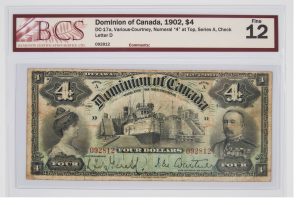
1902 Dominion of Canada $4 Note
Here’s a denomination you don’t see every day—the $4 bill. While the number four feels a bit awkward to us today, at the end of the 19th century, one British Pound was equal to four Canadian Dollars, making this a helpful denomination for merchants who may still have been keeping their ledgers in pounds, or were doing a lot of trade with British companies. Introduced in the 1880s, this note was kept in circulation until 1902.
The front of the note depicts a ship passing through the Canadian locks at the Sault Ste. Marie Canal, which had been completed in 1895. The canal straddled Canada’s border with the US, connecting Lake Superior with major Atlantic trade routes. The bill’s previous issue in 1900 (an example of which is included in the Numismatics auction) depicted the locks on the American side of the canal—Sault Ste Marie, Michigan—rather than the Canadian side. The 1900 notes were recalled, and the 1902 release corrected the issue. Despite the perfected imagery, the $4 bill didn’t last long, and 1902 marked the last time the Dominion of Canada used this denomination.
The front of the note also features portraits of Gilbert John Elliot-Murray-Kynynmound, 4th Earl of Minto and his wife Mary. Lord Minto was the eighth Governor General of Canada since Confederation in 1867, holding the position from 1898-1904. Up until 1911, low denomination notes featured Governors General and their wives instead of members of the Royal Family, acknowledging the former’s role as the Crown’s representative in Canada.
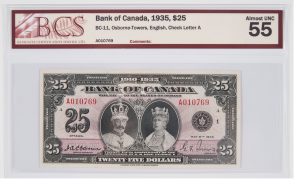
1935 Bank of Canada $25 note
This special royal purple note was the only $25 note ever issued by the Bank of Canada, as well as the only note to feature a vignette whose content was not Canadian. The front is dated “6 May 1935” to honour the Silver Jubilee of King George V, the first ever Silver Jubilee celebration of a British monarch (though not the first time a British monarch reigned for 25+ years). The $25 note was commemorative, and like the other notes in the 1935 series, was offered in both French and English (both examples which are on offer in the Numismatics auction). The $25 note was released two months after the other 1935 notes, and is notable for featuring a foreign scene on the back rather than a Canadian or allegorical subject – in this case, it depicts one of the Royal Family’s official residences, Windsor Castle.
Printed by the Canadian Bank Note Company, the front features portraits of King George V and Queen Mary which were engraved by Edwin Gunn and Will Ford of the American Bank Note Company. Windsor Castle was engraved by Louis Delmoce, who also worked for the American Bank Note Company.
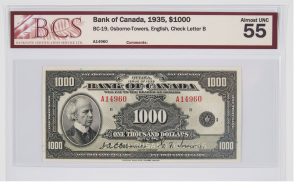
1935 Bank of Canada $1,000 Note
Bringing a whole new meaning to “burning a hole in your pocket” – imagine carrying tens of thousands of dollars on a single note? A 1935 $1000 note was roughly the equivalent to $21,000 in today’s currency. To put it into even more perspective, a 1935 Ford Model 48 2-door Coupe cost $495 when new—so this $1000 note could buy you two cars fresh off the lot. For more 1935 prices, this list will give you a good idea of just how much buying power $1000 would have given you.
1935 was an important year in Canadian numismatics history, as it marked the opening of the Bank of Canada on March 11. These earliest notes were produced separately in both English and French. Apart from the language differences, they were otherwise identical. These notes were designed not by the Bank itself but by security printers under contract to the federal government. Classic imagery in the style of the British Empire was chosen. Lower denominations in 1935 featured members of the Royal Family (including an eight-year-old future Queen Elizabeth II) while Prime Ministers John A. MacDonald and Wilfred Laurier were depicted on the $500 and $1000 note, respectively.
Laurier’s portrait depicts him in a Prince Albert coat and was rendered by Edwin Gunn, the American Bank Note Company’s master engraver. The back of the note depicts an allegorical stock image of “Security”—which had been used on several other notes previously, including a 1917 issue of Russian bonds. The $1000 note stopped being issued in Canada in 2000.
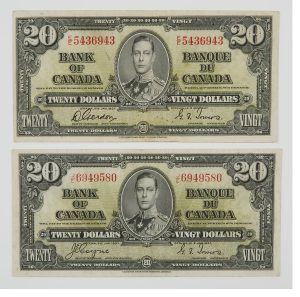
1937 Bank of Canada $20 Note
When King George V died in 1936, he was succeeded by his son Edward VIII. Edward held the position of king for less than 11 months, abdicating on December 11, 1936. Three kings in one calendar year meant that the Bank of Canada needed some quick redesigns, an opportunity which the Bank capitalized on. This opportunity would allow for the emergence of a distinctive, specifically Canadian currency style.
One of the most significant changes in 1937 was the use of both French and English on the same note, rather than the previous custom of producing separate bills in each language. French and English text bookended the official portrait—the King for common notes and Laurier and MacDonald for larger denominations—marking a shift from positioning the portrait image at the edges. The Bank of Canada explains that this new symmetry also “kept the King’s face safely away from the inky index fingers of bank clerks.”
One of the most distinctive hallmarks of Canadian paper money to this day is the use of different colours for different denominations, a practice which was refined with this 1937 series and has been used ever since. The $20 note seen here was produced on olive green rather than the pink of the 1935 release.
The reverse side of the 1937 series varied little from the 1935 series, though colour schemes and the placement of some numbers were adjusted for clarity and consistency. The speedy turnaround between monarchs in 1937 meant that the Bank of Canada was unable to do a major redesign—in the case of the $20, the Fertility motif seen on the back was borrowed from the back of the 1935 $500 bill.
About the auction
On View:
Monday, August 28 from 10:00 am to 5:00 pm
Tuesday, August 29 from 10:00 am to 5:00 pm
Offered online from August 26-31, the Numismatics auction features a fine collection of Canadian bank notes including numerous examples of ’Specimen’ notes from both 1937 and 1954 series; high grade French & English 1935 series notes; replacement notes; and both French and English versions of the 1935 $25 note. Also included are gold coins from numerous countries, silver coins lots, Olympic coins and commemoratives. Philatelists will enjoy an exceptional collection of Canadian stamps being sold as an album.
Please contact us for more information.
Related News
Meet the Specialists

Donald McLean
Senior Specialist

Livia Miliotis
Associate Specialist



